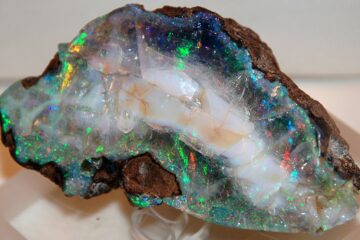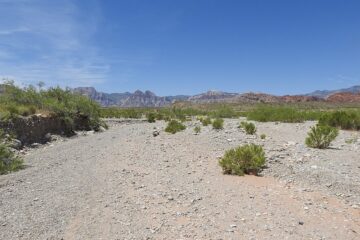How to identify gold ore
The ability to find high grade gold ore takes a practiced eye, careful prospecting and common sense. That being said, there are some visual clues that can narrow down your search.
Iron stained quartz
There are many different types of gold ores. I’m going to be talking here about oxidized desert quartz ores. Three reasons, one, they can have a relatively high gold content. Two, they are often the easiest to process (free milling). And three, they are the ones I have the most experience with.

Hematite on quartz
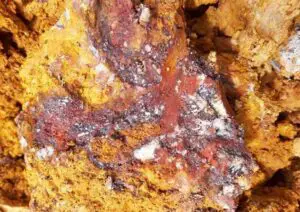
Oxidized gold quartz ore
Look over the waste rock dumps around the old mines and prospects in the areas that interest you. Get to know the characteristics of the various ores. No two gold ores are the same, but ores in the same general areas may be similar.
Look for iron stained quartz. The more oxidized or rust colored the better. The more porous or vuggy the better. High grade gold ore often has an almost melted sponge like appearance. Whereas the lower grade ores are usually more solid and angular and the quartz may have a glassy, somewhat smooth texture, especially when freshly broken.
A very high grade gold ore
The best gold ore I’ve found was at a small prospect in a very remote area between two old mining districts. This ore was a friable, highly oxidized quartz. The thick iron oxides present were an earthy, dark reddish brown hematite, along with two iron hydroxides, one a dark mustard yellow limonite and the other a dark brownish almost black goethite.
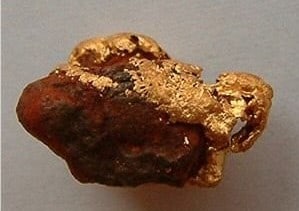
Native gold with hematite

Native gold and limonite
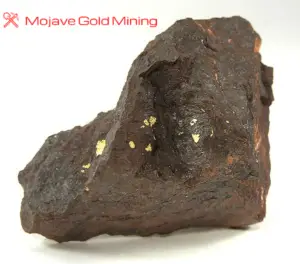 The three oxides had formed in distinct and separate bands and swirls that completely saturated the porous quartz. Reminding me of the way syrup saturates a snow cone.Their presence in the ore was caused by the weathering and replacement of an iron sulfide, specifically, iron pyrite. (check my post Pyrite – Fool’s Gold) for more on iron pyrite in ores.
The three oxides had formed in distinct and separate bands and swirls that completely saturated the porous quartz. Reminding me of the way syrup saturates a snow cone.Their presence in the ore was caused by the weathering and replacement of an iron sulfide, specifically, iron pyrite. (check my post Pyrite – Fool’s Gold) for more on iron pyrite in ores.
See links below for descriptions from Minerals.net
What made this ore unique, at least to me, was the fact that it contained two different gold types. By types I mean alloys. Native gold is always alloyed with silver, sometimes only a little, 97 or 98 percent gold alloyed with 2 or 3 percent silver. The hematite in this ore was carrying a 97% gold alloy at about 3 opt (ounces per ton) with a light rusty orange oxide coating. Very recognizable in the pan as gold.
Hidden gold
Now to the second gold type in this ore. The blackish earthy goethite was carrying an 80% gold, 20% silver alloy (electrum).
At over 40 opt gold (that’s right, 40 ounces per ton). It would concentrate in the pan next to the 97% gold. It looked like magnetite (black sands). Actually there was very little magnetite in this ore.
Upon closer inspection with a good jeweler’s loupe, (Amazon link to the Nikon triplet that I carry), we realized the fine black grains were tiny cubes, replacements, or pseudomorphs. Goethite after pyrite. No visual trace of gold in the pan. The oxide had coated the gold. I believe that the gold, because of the high silver content had also taken on a patina or tarnished slightly. Gold itself will not oxidize, but it can be “coated”.
Some Wikipedia links:
We gathered up an ounce or two of the goethite cubes, most the size of grains of salt, some a bit bigger, and put them in a beaker with a 10% dilute nitric solution and let them sit overnight.
The next morning, lo and behold, the black cubes had taken on a pale yellow color, the nitric had partially removed the oxide coating. Now under the loupe we could see that each cube was packed with small pieces of gold. If we hadn’t been paying attention, we might have missed out completely!
Needless to say we removed all the ore with the black goethite streaks that we could find.
Careful research
How did we find this deposit to begin with? We found a couple of x’s on an old paper USGS Quad sheet, (now available online at USGS.gov) or topographic quadrangle, indicating mining prospects.
We also researched some old mining reports, one stated that the main gold producing mine in the adjacent district had a 200 ft. shaft with fairly extensive workings (near surface). Another reference said that the ore averaged more than seven opt over the life of the mine. In another report for the other adjacent district it stated that the mines there were shallow, small, near surface workings, and were reported to have a high grade.
That’s it, a couple of sentences for each district. But enough to warrant a trip to try and find those prospects.
I relayed to you the above story, because it goes over the steps involved in locating a “textbook” high grade gold ore deposit from a real world perspective.
Summary:
Proper historic research of old mining districts to help search for multi ounce per ton high grade gold ore.
The use of historical USGS quad sheets to help locate remote prospects. See my post How to Read Topographic Maps
The importance of iron oxides together with quartz.
Thorough processing of collected samples.
Other prospecting posts that may interest you:
How to find gold – Area Research
How To Process Gold Ore Samples
How to use Google Earth as a prospecting research tool
Video showing some high grade gold ore
Check out the video below to get an up close look at some very high grade gold ore. This guy has a super informative YouTube channel called ColoradoGoldCamp. Based in Colorado, he’s a full time prospector and gold miner. He knows his stuff and this vid is packed with the information you’re going to need to know to find your own high grade mine.
